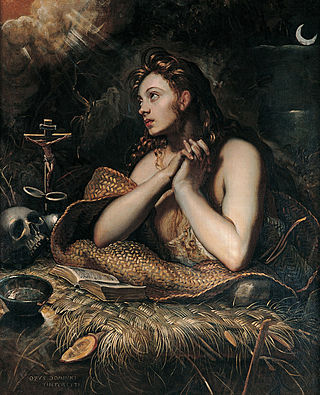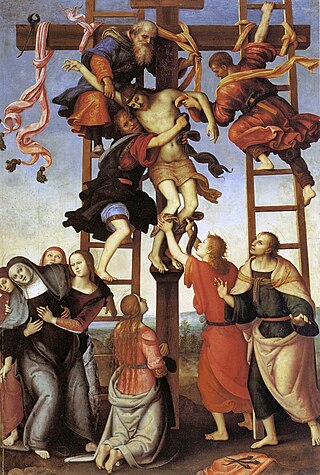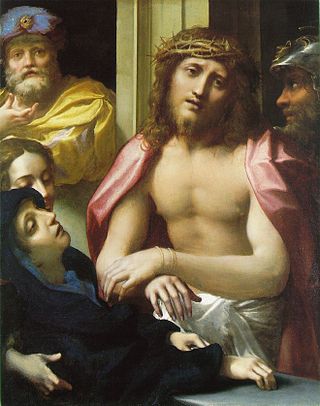
Mary Magdalene was a woman who, according to the four canonical gospels, traveled with Jesus as one of his followers and was a witness to his crucifixion and resurrection. She is mentioned by name twelve times in the canonical gospels, more than most of the apostles and more than any other woman in the gospels, other than Jesus's family. Mary's epithet Magdalene may be a toponymic surname, meaning that she came from the town of Magdala, a fishing town on the western shore of the Sea of Galilee in Roman Judea.

Antonio Allegri da Correggio, usually known as just Correggio, was the foremost painter of the Parma school of the High Italian Renaissance, who was responsible for some of the most vigorous and sensuous works of the sixteenth century. In his use of dynamic composition, illusionistic perspective and dramatic foreshortening, Correggio prefigured the Baroque art of the seventeenth century and the Rococo art of the eighteenth century. He is considered a master of chiaroscuro.

Noli me tangere is the Latin version of a phrase spoken, according to John 20:17, by Jesus to Mary Magdalene when she recognized him after his resurrection. The biblical scene has been portrayed in numerous works of Christian art from Late Antiquity to the present. The phrase has also been used in literature, and later in a variation by military units since the late 18th century.
Agrapha are sayings of Jesus that are not found in the canonical Gospels. The term was used for the first time by J.G. Körner, a German Bible scholar, in 1776.

John 20:17 is the 17th verse of the twentieth chapter of the Gospel of John in the New Testament. It contains Jesus' response to Mary Magdalene right after he confronts her just outside his tomb after his resurrection. According to the longer ending of Mark's Gospel Mary Magdalene is the first person to whom Jesus shows himself alive after his resurrection.

John 20:15 is the 15th verse of the twentieth chapter of the Gospel of John in the New Testament of the Christian Bible. Mary Magdalene has returned to Jesus' tomb and found it empty. She does not know that Jesus has risen from death and they begin conversing without her realizing his identity.

John 20:13 is the thirteenth verse of the twentieth chapter of the Gospel of John in the New Testament of the Christian Bible. This verse occurs after Mary Magdalene has found Jesus' tomb empty, except for two angels.

John 20:16 is the sixteenth verse in the twentieth chapter of the Gospel of John in the New Testament of the Bible. The verse describes the moment that Mary Magdalene realizes that Jesus has returned from the dead, when she recognizes his voice calling her name.

Matthew 14:28 is a verse in the fourteenth chapter of the Gospel of Matthew in the New Testament.

"John the Revelator" is a gospel blues call and response song. Music critic Thomas Ward describes it as "one of the most powerful songs in all of pre-war acoustic music ... [which] has been hugely influential to blues performers". American gospel-blues musician Blind Willie Johnson recorded "John the Revelator" in 1930. Subsequently, a variety of artists, including the Golden Gate Quartet, Son House, Depeche Mode, Jerry Garcia Band, The White Stripes, The Forest Rangers, The Sword, have recorded their renditions of the song, often with variations in the verses and music.

The Tribute Money is a fresco by the Italian Early Renaissance painter Masaccio, located in the Brancacci Chapel of the basilica of Santa Maria del Carmine, Florence. Painted in the 1420s, it is widely considered among Masaccio's best work, and a vital part of the development of Renaissance art.

Stabat Mater is a compositional form in the crucifixion of Jesus in art depicting the Virgin Mary under the cross during the crucifixion of Christ alongside John the apostle.

The Annunziata Polyptych is a painting cycle started by Filippino Lippi and finished by Pietro Perugino, whose central panel is now divided between the Galleria dell'Accademia and the Basilica dell'Annunziata, both in Florence, Italy. The polyptych had other six panels, which are housed in the Lindenau-Museum of Altenburg, the Metropolitan Museum of New York City, the Galleria Nazionale d'Arte Antica in Rome and in a private collection in South Africa.

Rabboni is a public artwork by American artist Gutzon Borglum, located Rock Creek Cemetery in Washington, D.C., United States. Rabboni was surveyed as part of the Smithsonian Save Outdoor Sculpture! survey in 1993. It is a tribute to Charles Matthews Ffoulke, prominent Washington banker and tapestry collector.

Noli me tangere is a c. 1514 painting by Titian of the Noli me tangere episode in St John's Gospel. The painting, depicting Jesus and Mary Magdalene soon after the resurrection, is in oil on canvas and since the nineteenth century has been in the collection of the National Gallery in London.
Noli me tangere is the Latin version of words spoken by Jesus to Mary Magdalene.

Christ and the Canaanite Woman is a 1594-1595 oil on canvas painting by Annibale Carracci, now in the Pinacoteca Stuard in Parma.

John 1:46 is the 46th verse in the first chapter of the Gospel of John in the New Testament of the Christian Bible.

John 1:48 is a verse in the first chapter of the Gospel of John in the New Testament.

Ecce Homo, also known as Christ Presented to the People, is an oil painting by Antonio da Correggio. It is the last of the surviving pictures of the Passion of Jesus that Correggio executed during the 1520s. The painting is in the National Gallery, London.



















